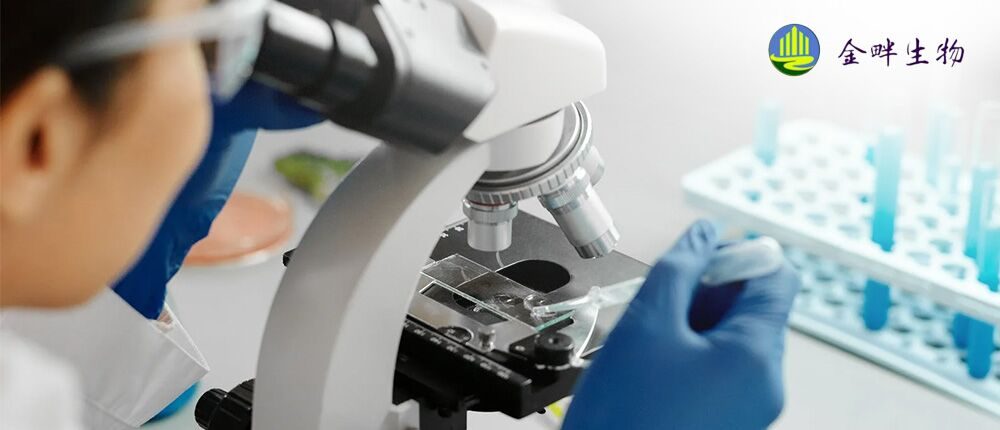CultureSure® Small Molecules
CultureSure® small molecules are reportedly involved in the processes of ES and iPS cell differentiation and maintaining their capacity to remain undifferentiated. The products are safe to be used in cell culture as their level of cytotoxicity has beenchecked and they have undergone mycoplasma and endotoxin tests. 1 mL preparation of Y-27632 solution is now available for use.
- A419259 Trihydrochloride
- CHIR99021
- CKI-7 Dihydrochloride
- IWP-2 & IWR-1-endo
- KY03-Ⅰ
- SB431542
- Y-27632
- Product List
- Related Information
A419259 Trihydrochloride

C29H34N6・3HCl=592.00
What is A419259?
SA419259 is an inhibitor of Src family kinases. Src is involved in the production of tyrosine kinases that specifically phosphorylate tyrosine residues of proteins. Src family kinases are considered to play important roles in cell development, differentiation and proliferation signaling pathways.
※Tested for endotoxin, tested negative for mycoplasma
Product Description
- Appearance: white to pale yellowish red, crystalline powder to powder
- Solubility: soluble in water, DMSO, ethanol, acetonitrile + water (1:1 ratio)
- Tested negative for mycoplasma
- Endotoxin: less than 0.1 EU/mg
- Storage: room temperature (under inert gas)
A-83-01
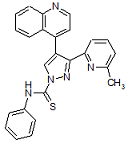
C25H19N5S=421.52
What is A-83-01?
A-83-01 is a selective inhibitor of ALK4, ALK5, and ALK7. It blocks phosphorylation of Smad2/3 and inhibits TGF-β-induced epithelial-to-mesenchymal transition. This product has little to no effect on bone morphogenetic protein type I receptors, p38 MAP kinase, and extracellular signal-regulated kinases. A-83-01 is known to help rat iPS cellscan be long-term cultured in a state maintaining the undifferentiated state.
※Tested for endotoxin, tested negative for mycoplasma
※Checked for cell cytotoxicity (using human iPS cell line 201B7)
Product Description
- Assay (HPLC): min. 98.0%
- Appearance: white to yellow, crystalline
- Ppowder to powder or mass
- Solubility: soluble in DMSO
- Tested negative for mycoplasma
- Endotoxin: less than 0.01 EU/mg
- Storage: -20°C in the dark (under inert gas)
References
Li, W., et al. : Cell Stem Cell, 4, 16 (2009).
Katsuda ,T., et al. : Cell Stem Cell, 20, 41 (2017).
Okae, H., et al. : Cell Stem Cell, 22, 50 (2018).
CHIR99021
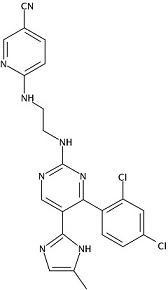
C22H18Cl2N8=465.34
What is CHIR99021?
CHIR99021 is a highly selective inhibitor of GSK-3β. The product does not exhibit cross-reactivity against CDKs.
CHIR99021 has been used to maintain effectively undifferentiated ES cells in combination with PD0325901.
※Tested for endotoxin, tested negative for mycoplasma
※Checked for cell cytotoxicity (using human iPS cell line 201B7)
Product Description (Powder Form)
- Assay (HPLC): min. 97.0%
- Appearance: white to pale brown, crystalline powder to powder
- Solubility: soluble in DMSO and methanol
- Tested negative for mycoplasma
- Endotoxin: less than 0.05 EU/mg
- Storage: -20°C in the dark
Product Description (Liquid Form)
- Appearance: liquid
- Concentration: dissolved in DMSO, 10 mmol/L
- Sterilized with 0.1 μm filter
- Tested for sterility
- Tested negative for mycoplasma
- Tested for endotoxin: less than 2 EU/mL (for the first lot)
- Storage: -20°C in the dark
- No animal-derived components were used in the raw materials and in the manufacturing processes
Reference
Ying, QL., et al .: Nature, 453, 519 (2008).
CKI-7 Dihydrochloride
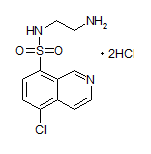
C11H12ClN3O2S・2HCl=358.67
What is CKI-7 Dihydrochloride?
イCKI-7 dihydrochloride is one of the isoquinoline sulfonamide, and is an ATP-competitive inhibitor that selectively inhibit casein kinase 1 (CK1). As a serine/ threonine kinase, CK1 regulates various processes such as nuclear export, cell cycle, cell division, and apoptosis. CKI-7 dihydrochloride is known for induce retinal progenitor cells from human ES and iPS cells in combination with SB431542 and Y-27632 under serum-free and feeder-free conditions.
※Tested for endotoxin, tested negative for mycoplasma
※Checked for cell cytotoxicity (using human iPS cell line 201B7)
Product Description (Powder Form)
- Assay (HPLC): min. 98.0%
- Appearance: white to pale brown, crystalline powder to powder
- Solubility: soluble in water
- Tested negative for mycoplasma
- Endotoxin: less than 0.05 EU/mg
- Storage: -20°C in the dark (under inert gas)
Product Description (Liquid Form)
- Appearance: liquid
- Concentration: dissolved in water, 3 mmol/L
- Sterilized with 0.1 μm filter
- Tested for sterility
- Tested negative for mycoplasma
- Tested for endotoxin: less than 1 EU/mL (for the first lot)
- Storage: -20°C in the dark
- No animal-derived components were used in the raw materials and in the manufacturing processes
Reference
Takahashi, M. et al.: J. Cell Sci., 122, 3169 (2009).
IWP-2 & IWR-1-endo
CultureSure® IWP-2
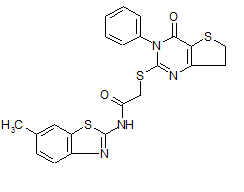
C22H18N4O2S3=466.60
What is IWP-2?
IWP-2 inactivates porcupine (Porcn), a membrane-bound o-acyltransferase (MBOAT), and suppresses palmitoylation of Wnt proteins. As a result, it blocks phosphorylation of Wnt-dependent Lrp-6 receptor and Dvl2, and accumulation ofβ-catenin. It is known that it promotes differentiation of human iPS cells into cardiomyocytes.
※Tested negative for mycoplasma
※Checked for cell cytotoxicity (using human iPS cell line 201B7)
Product Description
- Assay (HPLC): min. 98.0%
- Appearance: white to pale brown, crystals to powder
- Solubility: soluble in DMSO
- Tested negative for mycoplasma
- Storage: 2-10 °C in the dark (under inert gas)
Reference
Minami, I. et al.: Cell Rep., 2, 1448 (2012).
CultureSure® IWR-1-endo

C25H19N3O3=409.44
What is IWR-1-endo?
IWR-1-endo is an inhibitor of Wnt signaling. IWR-1 stabilizes the complex composed of Axin2, Apc, Ck1, and Gsk3β that degrades β-catenin. As a result, it promotes degradation of β-catenin.
※Tested for endotoxin, tested negative for mycoplasma
Product Description
- Assay (HPLC): min. 98.0%
- Appearance: white to pale yellow, crystalline powder to powder
- Solubility: soluble in DMSO
- Tested negative for mycoplasma
- Storage: -20 °C in the dark (under inert gas)
KY03-Ⅰ

C19H19IN2O3S=482.34
What is KY03-I?
KY03-I is an inhibitor of Wnt. It is known that KY02111 induces differentiation of human ES and iPS cells into cardiomyocytes. Compared with KY02111, KY03-I induces differentiation of ES/ iPS cells into cardiomyocytes in a more efficient manner and at a lower concentration.
※Tested for endotoxin, tested negative for mycoplasma
Product Description
- Assay (HPLC): min. 98.0%
- Appearance: white to pale gray, crystalline powder to powder
- Solubility: soluble in DMSO, ethanol, acetone, and methanol
- Tested negative for mycoplasma
- Endotoxin: less than 0.01 EU/mg
- Storage: -20 °C in the dark (under inert gas)
Reference
Minami, I. et al.: Cell Rep., 2, 1448 (2012).
SB431542
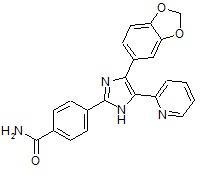
C22H16N4O3=384.39
What is SB431542?
SB431542 is a selective inhibitor of TGF-β superfamily type 1 activin receptor-like kinase (ALK) and inhibits ALK4, 5, and 7. It is known that it stimulates proliferation, differentiation and sheet formation of ES cells-derived endothelial cells. It is also known that the use of SB431542 with thiazovivin and PD0325901 improves reprogramming efficiency to more than 200 times and accelerates reprogramming speed.
※Tested for endotoxin, tested negative for mycoplasma
※Checked for cell cytotoxicity (using human iPS cell line 201B7)
Product Description (Powder Form)
- Assay (HPLC): min. 98.0%
- Appearance: white to slightly yellowish brown, crystalline powder to powder
- Solubility: soluble in DMSO, acetonitrile, acetone, and ethanol
- Tested negative for mycoplasma
- Endotoxin: less than 0.05 EU/mg
- Storage: -20 °C in the dark
Product Description (Liquid Form)
- Appearance: liquid
- Concentration: dissolved in DMSO, 5 mmol/L
- Sterilized with 0.1 μm filter
- Tested for sterility
- Tested negative for mycoplasma
- Tested for endotoxin: less than 2 EU/mL (for the first lot)
- Storage: -20°C in the dark
- No animal-derived components were used in the raw materials and in the manufacturing processes
References
Ogawa, K., et al. : J. Cell. Sci.,120, 55 (2007).
Lin T., et al. : Nat. Methods, 6, 805 (2009).
Fujimori, K., et al. : Stem Cell Reports., 9, 1 (2017).
Okae, H., et al. : Cell Stem Cell, 22, 50 (2018).
Y-27632
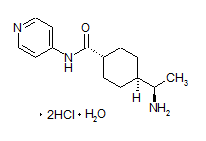
C14H21N3O・2HCl・H2O=338.27
What is Y-27632?
Y-27632 is a selective and potent inhibitor of ROCK. It induces various activities such as contraction of vascular smooth muscle cells via ROCK signaling pathways. Furthermore, it suppresses the cell death of of ES and iPS cells at cell dispersion, and that it improves cell survival after cryopreservation. [ROCK:Rho-associated coiled-coil forming kinase / Rho-linked kinase/ serine/threonine protein kinase]
※ Tested for endotoxin, tested negative for mycoplasma
※Checked for cell cytotoxicity (using human iPS cell line 201B7)
Product Description (Powder Form)
- Assay (HPLC): min. 98.0%
- Appearance: white to pale yellow, crystalline powder to powder
- Solubility: soluble in water and ethanol
- Specific rotation [α]D20(c=0.5,CH3OH) :+6.3°(for the first lot)
- Tested negative for mycoplasma
- Endotoxin: less than 0.25 EU/mg
- Storage: -20 °C in the dark (under inert gas)
Product Description (Liquid Form)
- Appearance: liquid
- Concentration: dissolved in water, 10 mmol/L
- Sterilized with 0.1 μm filter
- Tested for sterility
- Tested negative for mycoplasma
- Tested for endotoxin: less than 0.78 EU/mL (for the first lot)
- Storage: -20°C in the dark
- No animal-derived components were used in the raw materials and in the manufacturing processes
References
Uehata, M., et al. : Nature, 389, 990 (1997).
Sakamoto, K., et al. : J. Pharmacol. Sci., 92, 56 (2003).
Nishimaru, K., et al. : J. Pharmacol. Sci., 92, 424 (2003).
Watanabe, K., et al. : Nat. Biotechnol., 25, 681 (2007).
Martin-Ibanez, R., et al. : Hum. Reprod., 23, 2744 (2008).
Claassen, DA., et al. : Mol. Reprod. Dev., 76, 722 (2009).
Kawamata, M., et al. : Proc. Natl. Acad. Sci. USA., 107, 14223 (2010).
Ito, H., et al. : Liver Int., 32, 592 (2012).
Katsuda,T., et al. : Cell Stem Cell, 20, 41 (2017).
Okae, H., et al. : Cell Stem Cell, 22, 50 (2018).
Ogawa, K., et al. : Sci. Rep., 8, 3615 (2018).
Ayabe, H., et al. : Stem Cell Reports., 11, 306 (2018).
Product List
- Open All
- Close All
Related Information
Category
- Cell Culture
- Stem Cell Culture
- Undifferentiated State Maintenance / Differentiation Induction
Product content may differ from the actual image due to minor specification changes etc.
